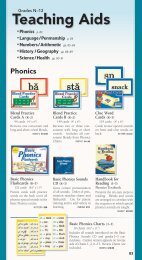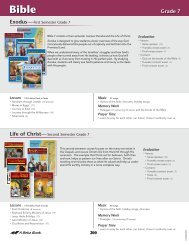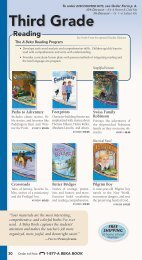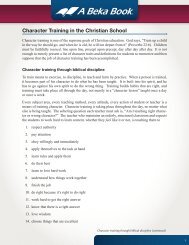Science & Health - A Beka Book
Science & Health - A Beka Book
Science & Health - A Beka Book
Create successful ePaper yourself
Turn your PDF publications into a flip-book with our unique Google optimized e-Paper software.
<strong>Science</strong>: Order & Design cont.<br />
Fish, Reptiles, & Amphibians (cold-blooded) cont.<br />
h Dinosaurs and similar creatures: descriptions of various types<br />
• Amphibians:<br />
h Anatomy<br />
• Metamorphosis<br />
• Salamanders, frogs, and toads<br />
h Salamander life cycles, estivation<br />
h Caecilians (limbless amphibians)<br />
Insects & Other Arthropods<br />
• Common characteristics of arthropods:<br />
• Basic common traits:<br />
h Open system of circulation<br />
• Jean-Henri Fabre—entomologist<br />
• Insect anatomy and life cycles:<br />
• Complete and incomplete metamorphosis<br />
h Structure of compound eyes<br />
• Insect orders:<br />
h Detailed description and examples for each order<br />
• Coleoptera (sheathed wings), Hemiptera (half-wing)<br />
• Homoptera (same wings), Diptera (two wings)<br />
• Orthoptera (straight wings), Odonata (toothed)<br />
h Neuroptera (nerve wings)<br />
• Hymenoptera (membrane wings), Lepidoptera (scale-wing)<br />
h Insects and man: helpful and harmful characteristics of insects<br />
• Crustacean anatomy and orders (aquatic arthropods):<br />
h Common anatomy<br />
• Orders:<br />
• Decapoda (ten feet)<br />
h Amphipoda (both legs), Copepoda (one eye), Branchiopoda<br />
(gill feet)<br />
• Cirripedia<br />
h Euphausiacea (shining bright)<br />
• Isopoda (equal feet), includes wood lice<br />
• Arachnid anatomy and groups:<br />
• Details of common anatomy<br />
• Spiders, harvestmen (daddy longlegs), scorpions<br />
h Pseudoscorpions<br />
• Mites, ticks<br />
• Centipedes and millipedes: comparison and contrast of traits<br />
Microbiology<br />
• Cell theory: introduction to the cell, Robert Hooke<br />
• Cell structure:<br />
• Basic structures and functions:<br />
h Plant cell structure and differences from human and animal cells<br />
• Algae:<br />
• Characteristics and types:<br />
h Classification; volvox, spirogyra<br />
• Fungi:<br />
• Characteristics and types:<br />
h Classification<br />
h Rusts, smuts<br />
h Yeast reproduction<br />
<strong>Science</strong><br />
160<br />
h red indicates NeW MATerIAL<br />
• Protozoa:<br />
• Leeuwenhoek, sarcodines, ciliates<br />
h Flagellates, sporozoa, vorticella, stentor<br />
h Bacteria: eukaryotes and prokaryotes, examples of helpful and harmful<br />
bacteria<br />
Forestry<br />
• Tree groups:<br />
• Basic traits of angiosperm and gymnosperm trees:<br />
h Cycads, ginkgoes<br />
• Tree structure:<br />
• Details of roots, stems, branches, and leaves:<br />
h Bark and wood as vascular tissue<br />
h Pith<br />
h Bud structure and types<br />
h Nodes and lenticels<br />
h Sun and shade leaves, leaf pigments<br />
h Locations of American forests: introduction and geographical<br />
description of North American forests<br />
h Branches of forestry: introductory concepts regarding forestry<br />
h Functions and resources of forests<br />
h Using forests: harvesting methods and renewing the resources<br />
• Notable tree species: details and characteristics of 24 types of North<br />
American trees<br />
h Forest conservation: Theodore Roosevelt, sustainability, reforestation,<br />
forest fires, disease, insects<br />
Ecology<br />
h Factors in an ecosystem:<br />
h Overview of factors affecting an ecosystem<br />
h Tolerance vs. optimum range<br />
h Limiting factor<br />
h Carrying capacity<br />
h Biodiversity<br />
h Biogeochemical cycles<br />
h Levels of ecology: biosphere, atmosphere, lithosphere, hydrosphere,<br />
community, population<br />
h Types of biomes:<br />
h Overview of traits and communities of:<br />
h Tundra, boreal forest, temperate deciduous forest<br />
h Grassland, tropical rainforest<br />
h Aquatic biomes<br />
h Nutrition types: traits and types of producers and consumers:<br />
• Food chains<br />
h Trophic levels<br />
h Food webs<br />
h Special nutritional relationships: predation, symbiosis, competition,<br />
and neutralism<br />
h Dominion and stewardship: role of man in the environment, biblical<br />
stewardship<br />
h Dangers of modern environmentalism: bias, pantheism<br />
• Biblical conservation:<br />
h Bible examples<br />
Grade 7

















